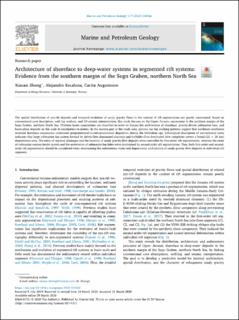| dc.contributor.author | Zhong, Xiaoan | |
| dc.contributor.author | Escalona, Alejandro | |
| dc.contributor.author | Augustsson, Carita | |
| dc.date.accessioned | 2021-02-15T13:27:49Z | |
| dc.date.available | 2021-02-15T13:27:49Z | |
| dc.date.created | 2020-06-11T12:11:50Z | |
| dc.date.issued | 2020-03 | |
| dc.identifier.citation | Zhong, X., Escalona, A., Augustsson, C. (2020) Architecture of shoreface to deep-water systems in segmented rift systems: Evidence from the southern margin of the Sogn Graben, northern North Sea. Marine and Petroleum Geology, 117, 104361 | en_US |
| dc.identifier.issn | 0264-8172 | |
| dc.identifier.uri | https://hdl.handle.net/11250/2728133 | |
| dc.description.abstract | Naturally fractured reservoirs are highly dependent on capillary forces to recover hydrocarbons during water injection. Water can spontaneously imbibe and expel oil if positive capillary forces exist; purely counter-current if all sides of the matrix blocks are exposed to water; and predominantly co-current with some counter-current production if the blocks are exposed to water and oil simultaneously. The latter is referred to as a co-current spontaneous imbibition (SI) setup. Wettability alteration (WA) has been identified as a key mechanism to improve oil recovery from naturally fractured reservoirs, however almost all experimental and modeling studies on WA during SI have focused on counter-current SI. Our review indicates limited systematic experimental work on co-current SI using nonzero initial saturation, mixed wettability or WA processes and This modeling study will investigate enhanced oil recovery by WA during co-current SI where a brine with a general WA component imbibes and causes the system to become more water-wet. We model a 1D oil-saturated core exposed to water at one end (inlet) and oil at the other end (outlet), thus facilitating co-current SI. The core is initially preferentially (not strongly) oil-wet with low SI potential. The component is both transported by the imbibing brine and diffuses towards the imbibition front. Adsorption of the component is assumed to improve the water-wetness of the porous medium and hence the SI potential. The model is parameterized using consistent capillary pressure and relative permeabilities from previous history matching of brine-dependent porous disc experiments. The behavior of co-current SI at mixed-wet state is examined and compared to that of literature strongly water-wet behavior. Both secondary and tertiary enhanced recovery by SI with WA component is then considered in the simulations. Important parameters such as mobility ratio (as via oil viscosity), capillary back pressure, WA component concentration, adsorption and time of WA component exposure are investigated. Under mixed-wet conditions, favorable and unfavorable mobility ratios do not limit oil production as can be the case for strongly wetted media at unfavorable mobility ratio. This is due to oil preserving mobility at all obtained saturations. A third or more of the total production was counter-current, which is high compared to strongly wetted media. It was shown that half the oil could be produced counter-currently as an upper limit. High oil mobility is preserved in the twophase region near the inlet and was found to ensure a high minimum fraction of counter-current production. Twice as much of the incremental oil from WA was produced counter-currently as co-currently, explained by increased oil relative permeability in the WA affected inlet region. Sensitivity analysis revealed that an opposite shift would reduce the incremental counter-current production despite raised local capillary forces. Capillary back pressure resists oil production at the inlet without limiting water from imbibing. As a result, capillary back pressure had significant impact on co-current SI simulations with fixed and changing wettability. The trends discovered in this study, both for mixed-wet and wettability alternating systems, are hoped to inspire future experimental measurements.
The spatial distribution of syn-rift deposits and temporal evolution of sandy gravity flows in the context of rift segmentation are poorly constrained. Based on conventional core description, well log analysis, and 3D seismic interpretation, this study focuses on the Upper Jurassic successions in the southern margin of the Sogn Graben, northern North Sea. Thirteen facies associations are classified in order to discuss the architecture of shoreface, gravity-driven submarine fans, and basin-plain deposits on the scale of centimeters to meters. In the eastern part of the study area, gamma-ray log stacking patterns suggest that northeast–southwest oriented shoreface successions underwent progradational-to-retrogradational deposition during the Oxfordian age. Lithological description of conventional cores indicates that large submarine fan system formed by debris-flow-dominated channels and turbidity-flow-dominated lobe complexes covers a broad (22 × 20 km) depositional area. The entry of regional drainages and the location of sandy gravity flow deposits were controlled by first-order rift segmentation, whereas the route of submarine canyon feeder system and the orientation of submarine fan lobes were determined by second-order rift segmentation. Thus, both first-order and second-order rift segmentation should be considered when determining the sedimentary facies and depositional architecture of sandy gravity flow deposits in individual rift segments. | en_US |
| dc.language.iso | eng | en_US |
| dc.publisher | Elsevier Ltd. | en_US |
| dc.rights | Navngivelse 4.0 Internasjonal | * |
| dc.rights.uri | http://creativecommons.org/licenses/by/4.0/deed.no | * |
| dc.subject | petroleumsgeologi | en_US |
| dc.title | Architecture of shoreface to deep-water systems in segmented rift systems: Evidence from the southern margin of the Sogn Graben, northern North Sea | en_US |
| dc.type | Peer reviewed | en_US |
| dc.type | Journal article | en_US |
| dc.description.version | publishedVersion | en_US |
| dc.rights.holder | © 2020 The Author(s) | en_US |
| dc.subject.nsi | VDP::Matematikk og Naturvitenskap: 400::Geofag: 450::Petroleumsgeologi og -geofysikk: 464 | en_US |
| dc.subject.nsi | VDP::Teknologi: 500::Berg‑ og petroleumsfag: 510::Geoteknikk: 513 | en_US |
| dc.source.pagenumber | 23 | en_US |
| dc.source.volume | 117 | en_US |
| dc.source.journal | Marine and Petroleum Geology | en_US |
| dc.identifier.cristin | 1815022 | |
| dc.source.articlenumber | 104361 | en_US |
| cristin.ispublished | true | |
| cristin.fulltext | original | |
| cristin.qualitycode | 1 | |

